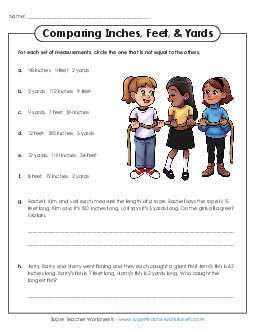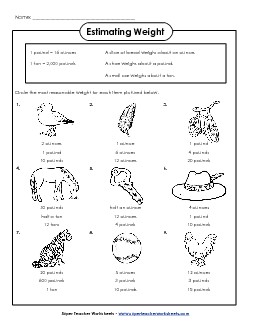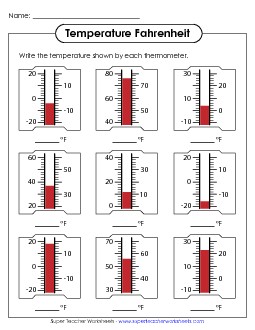Measurement Worksheets

(Inches, Feet, Yards, Miles)
Measure to the nearest inch, half inch, quarter inch, eighth inch. Convert between feet, inches, and yards.
Linear Measurement: Metric Units(Millimeters, Centimeters, Meters, Kilometers)
Measure to the nearest centimeter or millimeter. Convert between millimeters, centimeters, meters, and kilometers.
Linear Measurement: Non-Standard UnitsUse non-standard units to measure objects. (example: How many blocks long is the snake?) Also includes worksheets that use words longer, shorter, taller, and smaller.
Capacity: Standard Units(Gallons, Quarts, Liters, Cups, Pints)
Measure using gallons, quarts, pints, and cups. Many worksheets include GallonBot reference illustrations.
Capacity: Metric Units(Milliliters and Liters)
Measure using milliliter and liter metric units. Convert between milliliters and liters.
Liquid Volume: Graduated CylindersOn these worksheets, students must measure the volume of the liquids shown in the graduated cylinders.
Weight: Standard Units(Pounds, Ounces, Tons)
Find weight measurements in customary units (ounces, pounds, and tons). Convert between ounces, pounds, and tons.
Weight: Metric Units(Grams, Kilograms)
Find weight measurements in metric units (kilograms and grams). Convert between units.
Temperature / ThermometersThermometers worksheets in Celsius and Fahrenheit; Measure to the nearest degree
Area WorksheetsFind the areas of the rectangles, triangles, trapezoids, parallelograms, and circles.
Angle Worksheets (Measurement; Types)On these worksheets, students will use a protractor to determine the measurement of angle. They'll also learn types of angles (acute, obtuse, right, etc.).
Fraction WorksheetsThis page has lots of basic fraction worksheets. Identify fractions of a shape, as well as fractions of a set. Learn the difference between numerators and denominators.
Perimeter WorksheetsOn these printables, students will add the lengths of the sides of the polygons to find the perimeters.



Measurement is a crucial topic in elementary school math, where students learn to quantify the world around them by measuring lengths, capacities, weights, and temperatures. This topic is generally introduced in early grades, starting with simple length measurements in kindergarten and expanding to more complex measurement concepts in later grades. By the third and fourth grades, students are introduced to both standard units of measure, such as inches, feet, pounds, and Fahrenheit, as well as metric units like centimeters, meters, grams, and Celsius. Super Teacher Worksheets provides free measurement worksheets and activities to cover all of these areas, Understanding how to measure accurately allows students to grasp essential mathematical and scientific concepts, while also developing skills that are applicable to everyday life.
In the classroom, teachers use a variety of hands-on methods to help students understand measurement. Rulers, measuring tapes, and scales allow students to physically measure objects, helping them connect abstract concepts to real-world applications. For example, they might measure the length of a desk, the capacity of a container, or the weight of everyday items. Additionally, experiments involving temperature changes or volume measurements, such as tracking how water heats up or fitting objects into containers, help students apply measurement concepts to science lessons. Word problems and practical activities, such as comparing different weights or determining how much of a liquid fits into a container, also help students develop critical thinking and problem-solving skills.
Mastering the ability to measure and calculate correctly is essential for success in both math and real-world scenarios. Accurate measurement skills are foundational not only for future math topics like geometry and algebra but also for subjects like science, where precise data collection is vital. Whether estimating lengths, determining weights, or calculating capacities, students use measurement skills in everyday tasks, from cooking and building to understanding weather patterns. A strong grasp of both standard and metric units prepares students to navigate various situations where accurate measurements are necessary, fostering confidence in their ability to solve problems and interpret the world around them.






